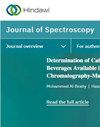Study of the Binding of Cuminaldehyde with Bovine Serum Albumin by Spectroscopic and Molecular Modeling Methods
IF 2.1
4区 化学
Q4 BIOCHEMICAL RESEARCH METHODS
引用次数: 6
Abstract
Here, we investigated the interaction of cuminaldehyde with a model carrier protein, bovine serum albumin (BSA). The formation of the BSA–cuminaldehyde complex was confirmed through ultraviolet–visible (UV–Vis) spectroscopy and further proven by detailed intrinsic fluorescence spectroscopic measurements. As observed, cuminaldehyde quenched the intrinsic tryptophanyl fluorescence of BSA. The fluorescence data, before the analyses, were corrected for the inner filter effect (IFE) because of the significant absorption of cuminaldehyde at the excitation wavelength that was employed in the measurements. The typical Stern–Volmer plots were slightly nonlinear; they exhibited negative deviation toward the x-axis, a typical phenomenon that is observed with proteins possessing more than one tryptophan residue. Thus, the modified Stern–Volmer equation was employed to analyze the data. The analyzed data revealed that the interaction of cuminaldehyde with BSA proceeded via a static quenching mechanism and that there was a fair 1 : 1 binding between them. The interaction was strengthened by hydrophobic forces and hydrogen bonding. A lowered concentration of cuminaldehyde did not affect the secondary structure of BSA, although an increased one partially exposed the protein by decreasing its α-helical contents. The molecular dockings and simulations of BSA and cuminaldehyde further confirmed the formation of the stable BSA–cuminaldehyde complex. The in silico results also revealed that the contributions of the hydrophobic interaction and hydrogen bonding were the driving forces that imparted the stability.用光谱和分子模拟方法研究孜然醛与牛血清白蛋白的结合
在这里,我们研究了孜然醛与模型载体蛋白牛血清白蛋白(BSA)的相互作用。通过紫外-可见(UV-Vis)光谱证实了bsa -孜然醛配合物的形成,并通过详细的本征荧光光谱测量进一步证实。结果表明,孜然醛猝灭了牛血清白蛋白固有的色氨酸荧光。在分析之前,由于测量中使用的激发波长对孜然醛的显著吸收,因此对荧光数据进行了内部过滤效应(IFE)的校正。典型的Stern-Volmer图具有轻微的非线性;它们表现出向x轴的负偏离,这是一种典型的现象,可以在含有不止一种色氨酸残基的蛋白质中观察到。因此,采用修正的Stern-Volmer方程对数据进行分析。分析结果表明,茴香醛与牛血清白蛋白的相互作用是通过静态猝灭机制进行的,两者之间存在公平的1:1结合。疏水力和氢键加强了相互作用。降低浓度的茴香醛不影响牛血清白蛋白的二级结构,而增加浓度的茴香醛通过降低其α-螺旋含量部分暴露了牛血清白蛋白。BSA与孜然醛的分子对接和模拟进一步证实了BSA -孜然醛稳定配合物的形成。结果还表明,疏水相互作用和氢键的贡献是赋予稳定性的驱动力。
本文章由计算机程序翻译,如有差异,请以英文原文为准。
求助全文
约1分钟内获得全文
求助全文
来源期刊

Journal of Spectroscopy
BIOCHEMICAL RESEARCH METHODS-SPECTROSCOPY
CiteScore
3.00
自引率
0.00%
发文量
37
审稿时长
15 weeks
期刊介绍:
Journal of Spectroscopy (formerly titled Spectroscopy: An International Journal) is a peer-reviewed, open access journal that publishes original research articles as well as review articles in all areas of spectroscopy.
 求助内容:
求助内容: 应助结果提醒方式:
应助结果提醒方式:


